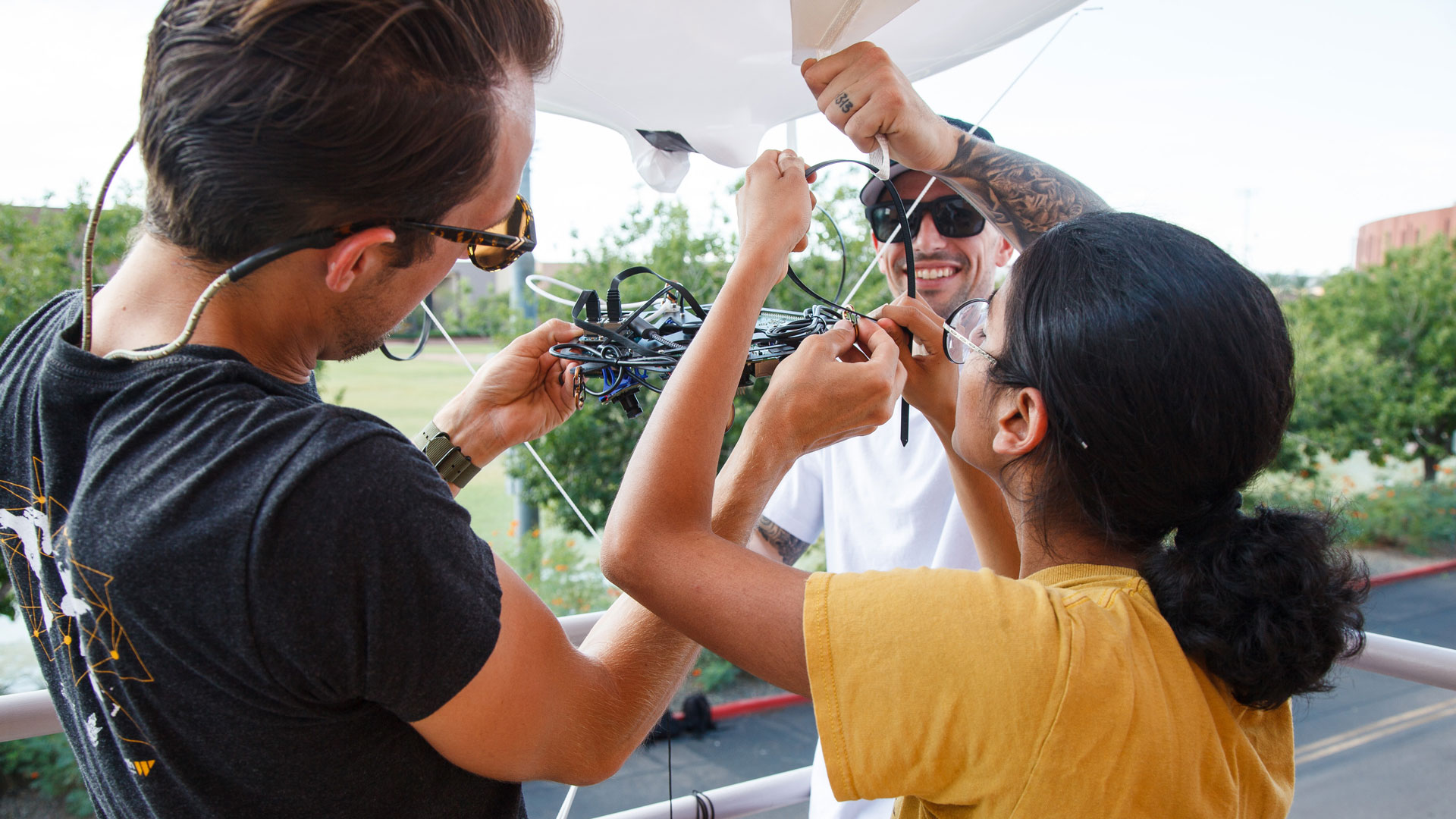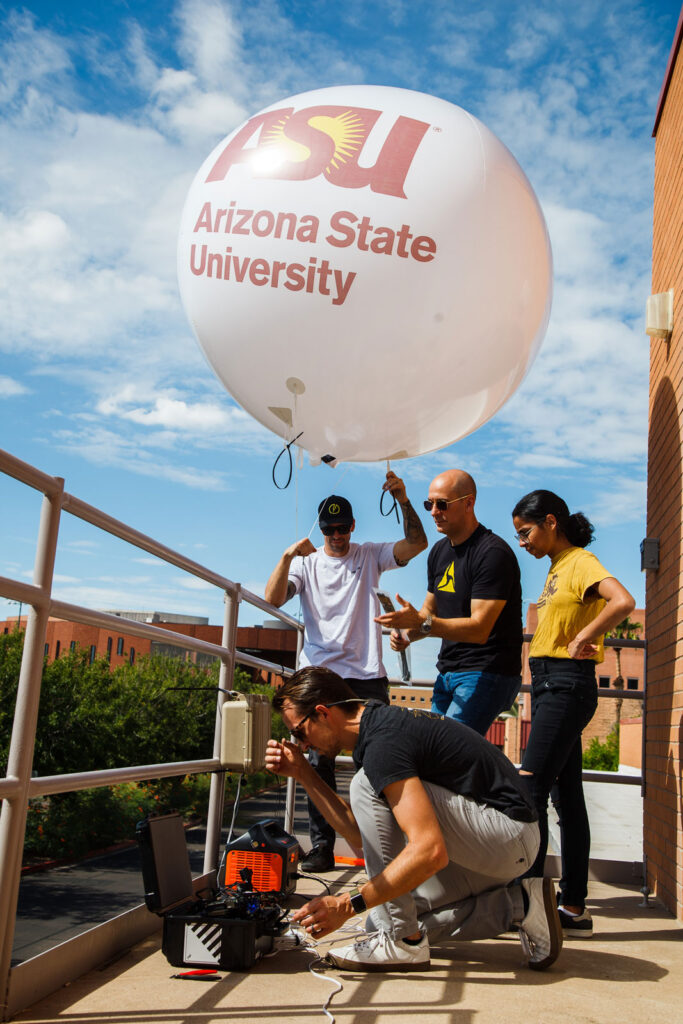
ASU students float new idea for event security
Industry collaboration between the ASU Luminosity Lab and Axon leads to innovative Guardian Balloon system for campus and football game safety

When you’re headed to a football game, you’re usually looking forward to the action on the field or enjoying time with your friends. But if you’re going to the ASU Homecoming game on Nov. 19, take a minute to look up on your way there. You may notice a set of large balloons equipped with innovative technology created by a team of top Arizona State University students.
These balloons, known as Guardian Balloons, are the result of a collaboration between Scottsdale-based safety technology company Axon and ASU students from the Luminosity Lab, a student-led research and development lab based in the Ira A. Fulton Schools of Engineering. The students worked with Axon professionals to come up with new ways to help secure large college campuses like ASU and university events like football games.
This effort is part of a larger experiment to create comprehensive security for the 21st century, says Karl Schultz, vice president and head of TASER Robotics at Axon. ASU students’ contributions are an integral part of the development process.
“Luminosity’s strengths are being able to take those large, real-world problems, break them down and develop solutions that cross different discipline boundaries and barriers,” says Tyler Smith, director of Luminosity Lab. “And by doing that, they are able to come up with one of the best possible solutions for the problem.”
Challenging problem
Large, open environments like the ASU Tempe campus pose big security challenges, which the Axon and Luminosity Lab team have been learning about from Dave Ellis, founder of GEMSEC Consulting.
Security teams must find a balance between public access and mitigating potential threats in these spaces. Ellis says solutions that enhance situational awareness over wide areas are one way to increase security without hindering people’s experiences.
“Having situational awareness and tools like the balloons that will allow you to be more efficient in monitoring your environment are really beneficial for not only stopping things before they happen, but should something happen, it gives those decision-makers more tools in their toolbox,” Ellis says.

The Guardian Balloons are helium-filled balloons that can be set up around an event. They can provide security teams a bird’s-eye view of a wide area to watch for potentially dangerous situations and enable those teams to quickly send help. Photographer: Alexander Chapin/ASU
Creative solution
The Luminosity Lab and Axon team is developing a flexible situational awareness tool that rises to meet security challenges.
The Guardian Balloons are helium-filled, tethered balloons equipped with cameras that capture 4K, high-resolution video. Multiple balloons launched to heights of around 60 to 100 feet can work together as one system to get a full view of an area like Sun Devil Stadium and the surrounding areas. Security teams can pan, tilt and zoom in on the video feed to watch for potentially dangerous situations that need attention.
The students have been working with the ASU Police Department to get feedback about the concept and capabilities safety agencies are interested in, Smith says. The department’s support in combination with Axon’s expertise has helped the team operationalize the Guardian Balloon technology for use in real-world settings like Sun Devil Stadium.
“The biggest challenge was the stability of the balloons to give a proper video feed that is useful for police officers,” says Jake McElroy, a senior program manager at Axon who has been working with the Luminosity Lab students during the project’s development. “The ASU team has done a fantastic job in countering these challenges using video stabilization, balloon redesign and alternative methods such as a hard mount.”
While balloons seem low-tech, they have advantages over helicopters and drones, which are typically used to get a bird’s-eye view of events. Comparatively, the balloons are quieter, cheaper, have fewer restrictions and are easier to use.
They’re also very scalable — additional balloons can be launched and integrated into the system from almost anywhere in as little as 20 minutes — which makes them better suited for scenarios in which hard-mounted cameras and the infrastructure they require are not optimal. Guardian Balloons can be powered by wired electrical and internet connections, or a battery and wireless connection to further increase the flexibility of the design.
“The ease of deployment and flexibility of location that comes with this [solution] pushes us to explore balloons as a new avenue for safety and event security,” says Ananay Arora, a computer science graduate student in the Fulton Schools who has been leading the Guardian Balloons’ software development. “The low cost while delivering much higher quality video also makes it a big win.”

ASU Luminosity Lab Director Tyler Smith (front), Axon Senior Program Manager Jake McElroy (back left), Axon Vice President Karl Schultz (back center) and ASU undergraduate student Hatvi Thakkar (back right) conduct a test of the Guardian Balloons from the top of the Memorial Union building on the ASU Tempe campus in early October. Photographer: Alexander Chapin/ASU
Interdisciplinary industry collaboration
Developing a situational awareness system for a complex security landscape requires a wide range of skills and expertise. The eight Luminosity Lab students who have worked on the project so far are undergraduate and graduate students in a variety of degree programs, including computer science, mechanical engineering, aerospace engineering, electrical engineering, business and industrial design.
Jacob Mansur, a junior in the industrial design program at The Design School at ASU, says he has used all of the fundamental skills he learned from his coursework and even learned new skills through his work on the project.
“With Luminosity, I’ve been given more mentorship than I’d typically have in a class and it has really helped me with understanding what is expected once I graduate with my bachelor’s degree,” Mansur says.
Companies, students and more than 400 ASU labs and facilities are brought together to solve problems and achieve concrete solutions by ASU Knowledge Enterprise Corporate Engagement and Strategic Partnerships.
“We work with all industries and all capabilities,” says Jon Relvas, business development director of Corporate Engagement and Strategic Partnerships.
Through Corporate Innovation Labs, Relvas says “companies see the hands-on work that these brilliant students can do and develop, and exposes the corporations to a win-win situation: the students get experience, and at the same time, the companies may create new solutions and IP [intellectual property], something that can go to the commercial market and gets applied to real-world challenges.”
Schultz, who was a professor of practice in the Fulton Schools before joining Axon, has been impressed by the diversity of perspectives and skills the students have brought to the project, and what they’ve achieved in a short amount of time.
“ASU students and the Luminosity Lab are very experienced at rapid prototyping, at practical engineering and manufacturing, not just writing a bunch of equations and saying we solved the problem,” Schultz says. “ASU really emphasizes that throughout the curriculum and it shows in the quality of work we get from these programs.”
In addition to getting cost-effective, innovative solutions and leveraging the creativity and passion of the students, collaborations such as the Guardian Balloon project are effective workforce development activities.
“Through this project, I was able to design models based on industry standards,” says Hatvi Thakkar, an aerospace and mechanical engineering senior who designed simulation models to test the balloon’s performance in various environmental conditions. “I also learned a lot about various manufacturing techniques for the components used in the assembly of the balloon.”
Success with more to come
McElroy has been impressed by the team’s ability to overcome challenges and improve the Guardian Balloons’ performance.
“When given operational feedback, the team can create a product within days to weeks that mirrors the requirements from Axon,” McElroy says. “This type of turnaround has allowed the team to stay on track to success.”
Their solution is nearing new heights in the development of a non-intrusive and effective way for security teams to quickly notice threats, analyze the situation and respond.
“I think the students came up with a great system that is effective, efficient, scalable, affordable and easily deployable,” Ellis says. “Oftentimes you don’t get all of that in a solution. And it solves not only the challenge of creating great situational awareness but it has other applications.”
The students are also planning ways to make the balloons a fun presence at ASU events, from using LED lights that can add to the spectacle to other helpful capabilities such as wayfinding features.
For now, it’s a rewarding experience for the Luminosity Lab students to see their solution in action at an ASU football game and to know there are bigger possibilities on the horizon.
“My team and I feel incredibly positive about what we’re doing,” Arora says, “which is using our engineering skills to build something that keeps the ASU community safe.”
Sandra Keaton Leander, assistant director of media relations at ASU Knowledge Enterprise, contributed to this story. Video by Jerrell Ayran, multimedia specialist for Strategic Marketing and Communications, and Alexander Chapin, multimedia producer for Strategic Marketing and Communications.



































